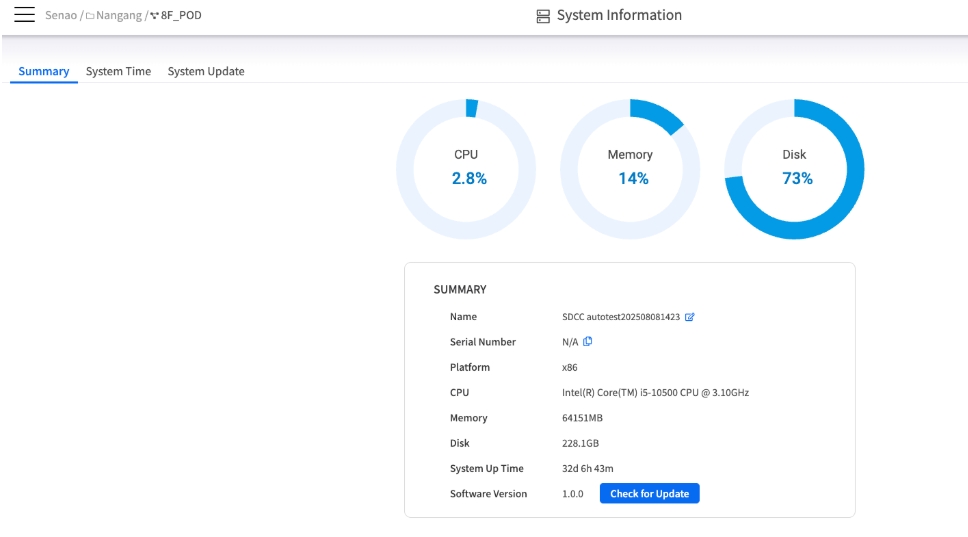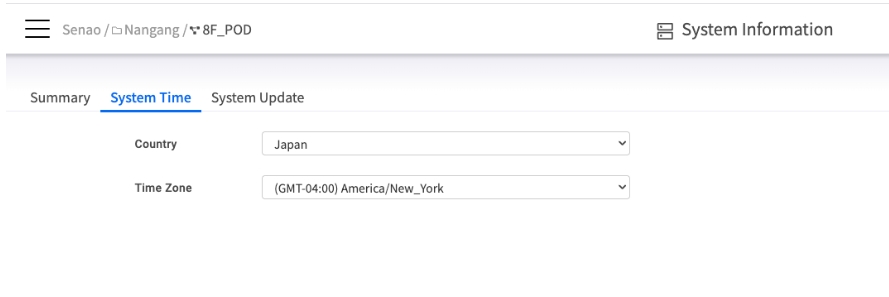System Information
Chapter 16.2: Monitoring EDCC Platform Health
Learn how to monitor the health of the EDCC host system, manage its core settings, and perform software updates.
🔐 Organization Administrator Only
Required Role: Organization Admin only
Access Level: Complete EDCC platform administration
Restriction: POD Admin and Viewers cannot access this section
Purpose: EDCC platform monitoring and system health
Overview: The EDCC Engine Room Control Panel
The System → System Information page is the central administrative dashboard for the EDCC platform itself, not the nodes it manages. Think of it as the control panel for the "engine room"—the underlying host system where the EDCC Docker container is running.
From here, an Organization-level Admin can perform three critical tasks:
Monitor Host System Health: Check the resource usage to ensure the platform has enough power to run efficiently.
Manage Core Platform Settings: Set the global time zone for accurate, platform-wide logging.
Perform Software Upgrades: Keep the EDCC application up-to-date with the latest features and security patches.
Task 1: Monitoring Host System Health (The Summary Tab)
This tab is your real-time "health gauge" for the host machine. If you find that the EDCC web interface is slow or unresponsive, this is the first place to investigate. High resource usage on the host system is a common cause of platform performance issues.

Resource Usage Meters
These three circular meters display the current resource load on the host system:
CPU
The percentage of total CPU capacity currently in use
Monitor for sustained high usage patterns
Memory
The percentage of total RAM currently consumed
Watch for memory leaks or capacity limits
Disk
The percentage of total disk storage space currently occupied
Plan for storage expansion before limits
Best Practice: Proactive Performance Management
Regularly monitor these meters. If any of them consistently show high usage (e.g., above 85%), it may indicate that the host system needs more resources (e.g., more RAM or disk space) to support your management workload.
System Details Explained
This panel provides key specifications about the EDCC platform and its host environment.
Name / Platform
The EDCC instance name and the CPU architecture of the host system (e.g., x86).
CPU / Memory / Disk
The model and total capacity of the host system's hardware resources. Why it matters: This allows you to quickly audit the host's specifications without needing to log in to the underlying operating system.
System Up Time
The duration for which the host system has been running continuously. Why it matters: A recent uptime can indicate an unexpected reboot of the host machine, which could explain platform unavailability.
Software Version
The currently installed version of the EDCC software. Why it matters: This is the first piece of information you will need when contacting technical support.
Check for Update
A button to manually verify if a newer version of the EDCC software is available.
Task 2: Managing Core Platform Settings (The System Time Tab)
This tab is used to set the global "master clock" for the EDCC platform. Setting the correct platform time zone is critical during initial deployment to ensure that all entries in the Event Log have accurate timestamps, vital for security audits and troubleshooting.

Configuration Process:
Select the Country where the EDCC platform is physically located
Select the specific Time Zone for that country
Click Apply
Understanding Time Zone Hierarchy
Important: Platform Time Zone vs. POD Time Zone
It's crucial to understand the difference between the two time zone settings in EDCC:
Platform Time Zone (set here)
Affects platform-wide logs, like the Event Log
Ensures all administrative actions are recorded with consistent, accurate timestamps
Security audits, troubleshooting correlation
POD Time Zone (set in CONFIGURE → General Settings)
Affects node-specific schedules within a POD
Allows scheduling maintenance for a POD in its own local time
Firmware provisioning, maintenance windows
Task 3: Upgrading the EDCC Platform (The System Update Tab)
This tab is used exclusively for upgrading the EDCC application software to newer versions. Keeping your platform up-to-date is essential for accessing new features, performance improvements, and critical security patches.

Update Process:
The Current Software Version field displays the version of EDCC currently running
Click Select File to browse for and upload the official EDCC update file (.img) provided by EnGenius
Follow the on-screen prompts to complete the upgrade process
Update Types Clarification
Common Mistake: Platform Update vs. Node Firmware Update
Do not confuse updating the EDCC platform with updating node firmware.
System Update (here)
Upgrades the EDCC management software itself
Platform features, security patches, performance
System → System Information
Firmware Provisioning
Upgrades the BMC/BIOS firmware on EnGenius nodes
Node hardware functionality, security
CONFIGURE → Firmware Provisioning
Platform Health Monitoring Best Practices
Performance Monitoring Guidelines
Daily Health Checks:
Review resource usage meters for trends
Monitor system uptime for unexpected reboots
Check for available software updates
Capacity Planning Thresholds:
CPU
>75% sustained
Investigate high-load processes
Consider more CPU cores
Memory
>80% sustained
Check for memory leaks
Plan RAM upgrade
Disk
>85% used
Clean up logs, plan expansion
Add storage capacity
Troubleshooting Performance Issues
Common Symptoms and Causes:
Slow web interface: High CPU or memory usage
Unresponsive pages: Disk I/O bottlenecks or full disk
Connection timeouts: Resource exhaustion on host system
Failed operations: Insufficient system resources
Diagnostic Steps:
Check resource meters for bottlenecks
Review system uptime for recent reboots
Verify adequate free disk space
Consider host system scaling if consistently high resource usage
Chapter Summary & Key Takeaways
This Page is for the Host: The settings and monitors here relate to the machine running EDCC, not the nodes being managed
Monitor Host Resources: High CPU, Memory, or Disk usage on the host will directly impact EDCC's performance and responsiveness
Platform Time is for Logs: The platform time zone ensures accurate timestamps in your global Event Log for auditing
POD Time is for Schedules: The POD time zone ensures maintenance windows run at the correct local time for that POD
Platform Updates are Separate: Updating the EDCC software here is a different process from updating the firmware on your nodes
Proactive Monitoring: Regular health checks prevent performance issues before they impact operations
What's Next: Chapter 16.3 will explore Application Settings configuration, where you'll learn to configure mail servers and file sharing for EDCC operations.
💡 Pro Tip: Set up a regular schedule to check platform health, especially before major operations like bulk firmware updates or large node deployments.